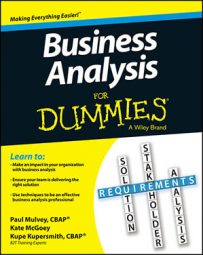You use decision tables to help analyze and communicate a company’s business rules. They’re a great way to show and clarify complicated business logic, particularly when you need to help stakeholders understand how different values work together to create a conclusion. Decision tables also help identify conditions you may not have thought out, so be on the lookout for conditions for which you have no conclusion.
A decision table contains multiple condition columns and a conclusion column. As you read across the rows, you gain more information until you arrive at your answer in the final column.
![[Credit: Illustration by Wiley, Composition Services Graphics]](https://www.dummies.com/wp-content/uploads/390504.image0.jpg)
You should apply this technique in situations such as the following:
When you need to make a set of complicated rules easier to understand
When you want to make the stakeholder review of business decisions more quickly and easily
When you want help in identifying missing conditions or conflicting conditions surrounding business logic
Keep these advantages of using decision tables in mind:
This technique helps you determine missing conditions (requirements). By breaking out the conditions, you not only show the known conditions but also expose the unknown conditions. If those unknown conditions have no conclusion, you have uncovered a missing requirement. For instance, what is the conclusion if a person has good employment history and no debt load? That condition hasn’t been identified.
Similarly, the example lists conditions for people with excellent employment histories and high, low, and nonexistent debt loads, but the Debt Load column also offers a value of Medium that isn’t accounted for in the excellent employment history category. This gap is an example of a missing condition (or requirement).
It’s also a good tool for developers and QA people because they can use the table to design and test the system very easily from the structure of this diagram.
Follow these steps to create a decision table:
Determine the decision you want to make.
In the example, that decision is assigning a person’s credit rating.
Figure out the variables you need answers to so that you can make that decision.
These variables — such as employment history and debt load — are your conditions.
Determine the valid values in each of the conditions.
By knowing all the valid values, you can figure out missing conclusions.
Determine where the data is coming from.
If the data comes from a different application, you may need another decision table to demonstrate what determines the values.
Set the decision from Step 1 as the last column heading and your conditions from Step 2 as the columns leading up to that.
Walk through the table, filling in the values (from Step 3) for each condition and drawing conclusions for each combination of the conditions.
You can see that if a person’s employment history is poor and his debt load is high, he receives a credit rating of D.

